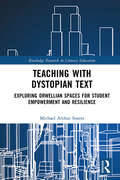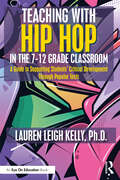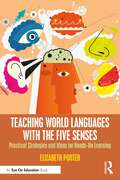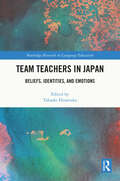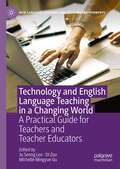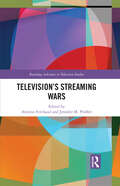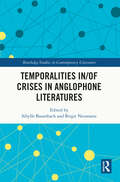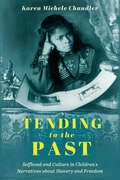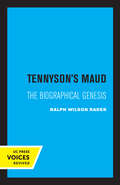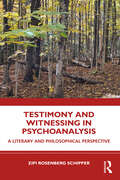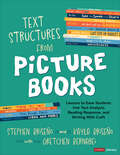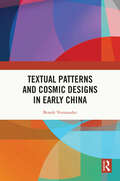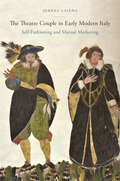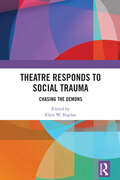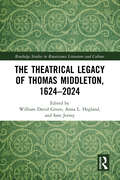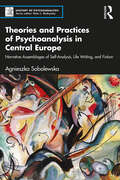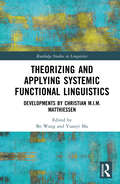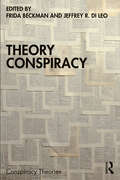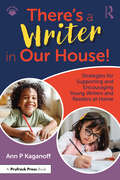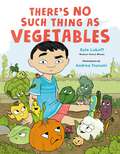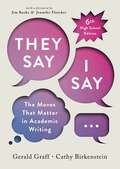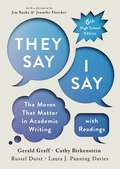- Table View
- List View
Teaching with Dystopian Text: Exploring Orwellian Spaces for Student Empowerment and Resilience (Routledge Research in Literacy Education)
by Michael Arthur SoaresTeaching with Dystopian Text propounds an exchange of spatial to pedagogical practices centered around “Orwellian Spaces,” signaling a new utility for teaching with dystopian texts in secondary education. The volume details the urgency of dystopian texts for secondary students, providing theoretical frameworks, classroom examples and practical research. The function of dystopian texts, such as George Orwell’s 1984, as social and political critique is demonstrated as central to their power. Teaching with Dystopian Text: Exploring Orwellian Spaces for Student Empowerment and Resilience makes a case that dystopian texts can be instrumental in the transfer of spatial practices to pedagogical practices. Pedagogical application creates links between the text and the student through defamiliarization, connecting the student to practices of resistance in the space of the classroom. The volume also addresses the challenges of teaching dystopian text in a dystopian educational climate including the COVID-19 lockdown. In addition to appealing to scholars and researchers of literacy education, language education and dystopian text, this book will also be a powerful yet accessible resource for secondary teachers as they address dystopian concerns with students in the complicated twenty-first century.
Teaching with Hip Hop in the 7-12 Grade Classroom: A Guide to Supporting Students’ Critical Development Through Popular Texts
by Lauren Leigh KellyThis book presents practical approaches for engaging with Hip Hop music and culture in the classroom. As the most popular form of music and youth culture today, Hip Hop is a powerful medium through which students can explore their identities and locate themselves in our social world. Designed for novice and veteran teachers, this book is filled with pedagogical tools, strategies, lesson plans, and real-world guidance on integrating Hip Hop into the curriculum. Through a wide range of approaches and insights, Lauren Leigh Kelly invites teachers to look to popular media culture to support students’ development and critical engagement with texts. Covering classroom practice, assessment strategies, and curricular and standards-based guidelines, the lessons in this book will bolster students’ linguistic and critical thinking skills and help students to better understand and act upon the societal forces around them. The varied activities, assignments, and handouts are designed to inspire teachers and easily facilitate modification of the assignments to suit their own contexts. The impact of Hip Hop on youth culture is undeniable, now more than ever; this is the perfect book for teachers who want to connect with their students, support meaning-making in the classroom, affirm the validity of youth culture, and foster an inclusive and engaging classroom environment.
Teaching World Languages with the Five Senses: Practical Strategies and Ideas for Hands-On Learning
by Elizabeth PorterWith this fun, practical guide, you will have everything you need to re-envision and reinvigorate your world language classroom. Author Elizabeth Porter draws on a brain-based approach to show how language learning is a sensory experience. Students can effectively learn languages and improve retention through activities and lessons that incorporate the five senses – sight, hearing, taste, touch, and smell. Chapters include real-world, research-backed examples and classroom strategies and activities ready for use. An essential resource for world language teachers, this book introduces language learning philosophy and an out-of-the-box, effective approach that uses neuroscience combined with best practices to promote a highly engaging language learning environment.
Teaching World Languages with the Five Senses: Practical Strategies and Ideas for Hands-On Learning
by Elizabeth PorterWith this fun, practical guide, you will have everything you need to re-envision and reinvigorate your world language classroom. Author Elizabeth Porter draws on a brain-based approach to show how language learning is a sensory experience. Students can effectively learn languages and improve retention through activities and lessons that incorporate the five senses – sight, hearing, taste, touch, and smell. Chapters include real-world, research-backed examples and classroom strategies and activities ready for use. An essential resource for world language teachers, this book introduces language learning philosophy and an out-of-the-box, effective approach that uses neuroscience combined with best practices to promote a highly engaging language learning environment.
Team Teachers in Japan: Beliefs, Identities, and Emotions (Routledge Research in Language Education)
by Takaaki HiratsukaThis book provides insights into the professional and personal lives of local language teachers and foreign language teachers who conduct team-taught lessons together. It does this by using the Japanese context as an illustrative example. It re-explores in this context the professional experiences and personal positionings of Japanese teachers of English (JTEs) and foreign assistant language teachers (ALTs), as well as their team-teaching practices in Japan. This edited book is innovative in that 14 original empirical studies offer a comprehensive overview of the day-to-day professional experiences and realities of these team teachers in Japan, with its focus on their cognitive, ideological, and affective components. This is a multifaceted exploration into team teachers in their gestalt—who they are to themselves and in relation to their students, colleagues, community members, and crucially to their teaching partners. This book therefore offers several empirical and practical applications for future endeavors involving team teachers and those who engage with them—including their key stakeholders, such as researchers on them, their teacher educators, local boards of education, governments, and language learners from around the world.
Technology and English Language Teaching in a Changing World: A Practical Guide for Teachers and Teacher Educators (New Language Learning and Teaching Environments)
by Ju Seong Lee Di Zou Michelle Mingyue GuThis edited book explores the integration of technology into English language education, with a particular focus on extracurricular and extramural contexts. The editors and an international team of scholars discuss how English teachers can critically and systematically design and implement language activities inside and outside the classroom to improve students’ receptive and productive skills. The book also discusses how teachers can harness technology to enhance their teaching practices. The combination of theory, digital materials, teaching activities, evidence-based reflections, and a focus on Extracurricular and Extramural contexts will make this book an invaluable resource for pre-service and in-service language teachers on ESL, EFL, and TESOL courses, as well as researchers in Applied Linguistics.Chapter 12 is available open access under a Creative Commons Attribution 4.0 International License via link.springer.com.
Telecollaboration in Translator Education: Implementing Telecollaborative Learning Modes in Translation Courses (Routledge Advances in Translation and Interpreting Studies)
by Mariusz MarczakThis volume provides a comprehensive treatment of telecollaboration as a learning mode in translator education, surveying the state-of-the-art, exploring its distinctive challenges and affordances and outlining future directions in both theoretical and practical terms. The book begins with an overview of telecollaboration and its rise in prominence in today’s globalised world, one in which developments in technology have significantly impacted practices in professional translation and translator education. The volume highlights basic design types and assessment modes and their use in achieving competence-based learning outcomes, drawing on examples from seven telecollaboration projects. In incorporating real-life research, Marczak draws readers’ attention to not only the practical workings of different types of projects and their attendant challenges but also the opportunities for educators to diversify and optimize their instructional practices and for budding translators to build competence and better secure their future employability in the language service provision industry. This volume will be a valuable resource for students and researchers in translation studies, particularly those with an interest in translator education and translation technology, as well as stakeholders in the professional translation industry.
Television’s Streaming Wars (Routledge Advances in Television Studies)
by Arienne Ferchaud Jennifer M. ProffittThis volume addresses contemporary debates and trends regarding the production and distribution, content, and audience engagement with the television streaming industry. The book interrogates the economics and structure of the industry, questions the types and diversity of content perpetuated on streaming services, and addresses how audiences engage with content from US and global perspectives and within various research paradigms. Chapters address television streaming wars, including the debates and trends in terms of its production and competition, diversity and growth of programming, and audience consumption, focusing on multiple platforms, content, and users. This timely and creative volume will interest students and scholars working in television studies, media industry studies, popular culture studies, audience studies, media psychology, critical cultural studies and media economics.
Temporalities in/of Crises in Anglophone Literatures (Routledge Studies in Contemporary Literature)
by Sibylle Baumbach Birgit NeumannLiterary works play a crucial role in modelling and conceptualising temporalities. This becomes particularly apparent in times of crises, which put conventionalised temporal patterns and routines under pressure. During crises, past, present, and future appear to collapse into each other and give way to temporal disjunction and rupture. Offering pluralised and context-sensitive approaches to temporalities in and of crises, this volume explores how literature’s engagement with crises suggests both the need for and possibility of rethinking ‘time’. The volume is committed to examining the affordances of specific genres and their potential in pointing beyond temporalities of crises to facilitate a sense of futurity. Individual essays are grounded in recent theories of temporality and literary form, which are related to novel advancements in ecocriticism, queer studies, affect theory, and postcolonial studies. The chapters cover a broad range of examples from different literary genres to reveal the knowledge of literature about temporalities in and of crises.
Tending to the Past: Selfhood and Culture in Children's Narratives about Slavery and Freedom (Children's Literature Association Series)
by Karen Michele ChandlerIn many popular depictions of Black resistance to slavery, stereotypes around victimization and the heroic efforts of a small number of individuals abound. These ideas ignore the powers of ordinary families and obscure the systematic working of racism. Tending to the Past: Selfhood and Culture in Children’s Narratives about Slavery and Freedom examines Black-authored historical novels and films for children that counter this distortion and depict creative means by which ordinary African Americans survived slavery and racism in early America. Tending to the Past argues that this important, understudied historical writing—freedom narratives—calls on young readers to be active, critical thinkers about the past and its legacies within the present. The book examines how narratives by children’s book authors, such as Joyce Hansen, Julius Lester, Marilyn Nelson, and Patricia McKissack, and the filmmakers Charles Burnett and Zeinabu irene Davis, were influenced by Black cultural imperatives, such as the Black Arts Movement, to foster an engaged, culturally aware public. Through careful analysis of this rich body of work, Tending to the Past thus contributes to ongoing efforts to construct a history of Black children’s literature and film attuned to its range, specificity, and depths. Tending to the Past provides illuminating interpretations that will help scholars and educators see the significance of the freedom narratives’ reconstructions in a neoliberal era, a time of shrinking opportunities for many African Americans. It offers models for understanding the powers and continuing relevance of the Black child’s creative agency and the Black cultural practices that have fostered it.
Tennyson's Maud: The Biographical Genesis
by Ralph W. Rader"This book was born out of the curiosity aroused in me by Tennyson's Maud and "Locksley Hall," ostensibly dramatic poems which were strangely flawed, I always felt, by some hidden emotional connection with the poet's own life. What was it? . . . The final result of my inquiry is this book." --From the Preface by the Author This title is part of UC Press's Voices Revived program, which commemorates University of California Press's mission to seek out and cultivate the brightest minds and give them voice, reach, and impact. Drawing on a backlist dating to 1893, Voices Revived makes high-quality, peer-reviewed scholarship accessible once again using print-on-demand technology. This title was originally published in 1963.
Testimony and Witnessing in Psychoanalysis: A Literary and Philosophical Perspective
by Zipi Rosenberg SchipperIn this fascinating volume, Zipi Rosenberg Schipper approaches the fundamental topic of testimony, seeking to recognize its value as a distinct and vital function in psychoanalytic work, separate from its inherited importance to work on trauma. Rosenberg Schipper introduces a revivifying philosophical, linguistic and psychoanalytic approach to the act of testimony, focusing on the role of witnessing in daily life and the importance it has as a therapeutic tool in psychoanalytic and psychological therapy. Throughout, she pinpoints three key psychoanalytic theories on patient testimony. She begins by looking at Freud’s foundational work on testimony as a means of concealing the unconscious and the questions of credibility in the consulting room this creates before looking at Winnicottian and Kohutian theories, whereby therapists take everything the patient says as a definitive truth. She concludes by looking at the Intersubjective and Relational schools of thought, where the therapist assumes the role of witness. By providing a comprehensive overview of the conflicting theories on the topic, Rosenberg Schipper equips practicing psychoanalysts and analysts-in-training with the tools necessary to utilize this vital therapeutic device and engage with it in treatment for all patients.
Text Structures From Picture Books [Grades 2-8]: Lessons to Ease Students Into Text Analysis, Reading Response, and Writing With Craft (Corwin Literacy)
by Stephen Briseño Kayla Briseño Gretchen BernabeiTeach students the architecture beneath a successful story—and boost their reading comprehension and writing skills for a lifetime Writing instruction can sometimes seem scattershot, as teachers try to cover a galaxy of craft techniques, ideas, intentions, and genres. The possibilities are endless—and that’s the problem. In Text Structures from Picture Books, elementary and middle grade teachers tap into a well-ordered universe of inspiring and illustrative stories to help students frame their thinking and focus choices. Using the bite-size format of picture books as a starting point, the authors share 50 low-prep, quick-access lessons to help you teach students seven concrete ways to respond to text in any genre. Through these lessons, students will be able to: Generate their own writing, using a text structure harvested from the work of professional authors Retell a story, using the text structure from the story Generate reading responses, using structures that support clarity Analyze a story to construct thematic statements, capturing the author’s message and bigger themes Write about a theme or big idea demonstrating empathic and evidence-based interpretation Answer open-ended questions by selecting a technique that reflects the text and their engagement Experiment with author’s craft in their own writing Based on master writing teacher Gretchen Bernabei’s instructional model, the lessons offer a lively, high-impact mix of reading aloud, discussion, modeling, student writing, and peer share. Plus, readers have access to a complete companion website full of text structure reproducibles, reading response prompts, additional lessons and extensions, students samples, and links to demo videos. State tests are now assessing reading and writing together. And that’s a good thing—but we’ve got some catching up to do. Written for students beginning in second grade, Text Structures from Picture Books will help your students swiftly and surely become text-savvy readers and writers.
Text Structures From Picture Books [Grades 2-8]: Lessons to Ease Students Into Text Analysis, Reading Response, and Writing With Craft (Corwin Literacy)
by Stephen Briseño Kayla Briseño Gretchen BernabeiTeach students the architecture beneath a successful story—and boost their reading comprehension and writing skills for a lifetime Writing instruction can sometimes seem scattershot, as teachers try to cover a galaxy of craft techniques, ideas, intentions, and genres. The possibilities are endless—and that’s the problem. In Text Structures from Picture Books, elementary and middle grade teachers tap into a well-ordered universe of inspiring and illustrative stories to help students frame their thinking and focus choices. Using the bite-size format of picture books as a starting point, the authors share 50 low-prep, quick-access lessons to help you teach students seven concrete ways to respond to text in any genre. Through these lessons, students will be able to: Generate their own writing, using a text structure harvested from the work of professional authors Retell a story, using the text structure from the story Generate reading responses, using structures that support clarity Analyze a story to construct thematic statements, capturing the author’s message and bigger themes Write about a theme or big idea demonstrating empathic and evidence-based interpretation Answer open-ended questions by selecting a technique that reflects the text and their engagement Experiment with author’s craft in their own writing Based on master writing teacher Gretchen Bernabei’s instructional model, the lessons offer a lively, high-impact mix of reading aloud, discussion, modeling, student writing, and peer share. Plus, readers have access to a complete companion website full of text structure reproducibles, reading response prompts, additional lessons and extensions, students samples, and links to demo videos. State tests are now assessing reading and writing together. And that’s a good thing—but we’ve got some catching up to do. Written for students beginning in second grade, Text Structures from Picture Books will help your students swiftly and surely become text-savvy readers and writers.
Textual Patterns and Cosmic Designs in Early China
by Benoît VermanderVia a hermeneutics focused on Chinese numerology and concentric arrangements, this book offers a novel construal of the textual universe proper to early China writings.The author lays bare distinguishable patterns of textual composition while relating them to corresponding patterns of thinking. He differentiates rhetorical variants through detailed studies of the Zhuangzi’s Inner chapters, the Laozi, the Analects, and the Huainanzi. The philosophical depth and relevance of the Chinese ancient worldview appear in a fresh light when one unearths the patterns into which its content is embedded. The focus on textual patterns and rhetorical arrangements also facilitates the reading of Chinese classics alongside other traditions.The book will be a valuable reference for scholars and graduate students studying Chinese literary criticism, Chinese philosophy, and comparative philosophy.
The Theatre Couple in Early Modern Italy: Self-Fashioning and Mutual Marketing (Performing Celebrity)
by Serena LaienaWho were the first celebrity couples? How was their success forged? Which forces influenced their self-fashioning and marketing strategies? These questions are at the core of this study, which looks at the birth of a phenomenon, that of the couple in show business, with a focus on the promotional strategies devised by two professional performers: Giovan Battista Andreini (1576–1654) and Virginia Ramponi (1583–ca.1631). This book examines their artistic path – a deliberately crafted and mutually beneficial joint career – and links it to the historical, social, and cultural context of post-Tridentine Italy. Rooted in a broad research field, encompassing theatre history, Italian studies, celebrity studies, gender studies, and performance studies, The Theatre Couple in Early Modern Italy revises the conventional view of the Italian diva, investigates the deployment of Catholic devotion as a marketing tool, and argues for the importance of the couple system in the history of Commedia dell’Arte, a system that continues to shape celebrity today.
Theatre Responds to Social Trauma: Chasing the Demons (Routledge Series in Equity, Diversity, and Inclusion in Theatre and Performance)
by Ellen W. KaplanThis book is a collection of chapters by playwrights, directors, devisers, scholars, and educators whose praxis involves representing, theorizing, and performing social trauma.Chapters explore how psychic catastrophes and ruptures are often embedded in social systems of oppression and forged in zones of conflict within and across national borders. Through multiple lenses and diverse approaches, the authors examine the connections between collective trauma, social identity, and personal struggle. We look at the generational transmission of trauma, socially induced pathologies, and societal re-inscriptions of trauma, from mass incarceration to war-induced psychoses, from gendered violence through racist practices. Collective trauma may shape, protect, and preserve group identity, promoting a sense of cohesion and meaning, even as it shakes individuals through pain. Engaging with communities under significant stress through artistic practice offers a path towards reconstructing the meaning(s) of social trauma, making sense of the past, understanding the present, and re-visioning the future.The chapters combine theoretical and practical work, exploring the conceptual foundations and the artists’ processes as they interrogate the intersections of personal grief and communal mourning, through drama, poetry, and embodied performance.
The Theatrical Legacy of Thomas Middleton, 1624–2024 (Routledge Studies in Renaissance Literature and Culture)
by William David Green Anna L. Hegland Sam JermyThis volume celebrates Thomas Middleton’s legacy as a dramatist, marking the 400th anniversary of Middleton’s final and most contentious work for the public theatres, A Game at Chess (1624).The collection is divided into three sections: ‘Critical and Textual Reception’, ‘Afterlives and Legacies’, and ‘Practice and Performance’. This division reflects the book’s holistic approach to Middleton’s canon, and its emphasis on the continuing significance of Middleton’s writing to the study of early modern English drama. Each section offers an assessment of the place of Middleton’s drama in culture, criticism, and education today through a range of critical approaches.Featuring work from a range of voices (from early career, independent, and seasoned academics and practitioners), the collection will be appropriate for both specialists in early modern literature and drama who are interested in both theory and practice, and students or scholars researching Middleton’s historical significance to the study of early theatre.
Theories and Practices of Psychoanalysis in Central Europe: Narrative Assemblages of Self-Analysis, Life Writing, and Fiction (History of Psychoanalysis)
by Agnieszka SobolewskaTheories and Practices of Psychoanalysis in Central Europe explores the close relationship between psychoanalysis, psycho-medical discourses, literature, and the visual arts of the late 1800s and early 1900s in Central Europe. Agnieszka Sobolewska addresses the issue of theories and practices of psychoanalysis in Central Europe and the need to undertake interdisciplinary reflection on the specificity of psychoanalytic literary genres and fin-de-siècle psycho-medical discourses. With a focus on the circulation of Freudianism in the territories of present-day Austria, Hungary, the Czech Republic, Poland, and Germany, the book considers the creative transformations that psychoanalytic thought underwent in these countries and reflects on the specificity of psychoanalytic literary genres and the pivotal role of lifewriting genres in the psychoanalytic movement. Sobolewska’s work both fills a visible gap in research on the history of psychoanalysis in Central Europe before the outbreak of World War II and offers the first insightful analysis of the role of life writing in the development of psychoanalytic thought. Theories and Practices of Psychoanalysis in Central Europe will be of great interest to psychoanalysts in practice and in training as well as scholars of the history of psychoanalysis, the history of psychology, literature, cultural anthropology, and modernism.
Theorizing and Applying Systemic Functional Linguistics: Developments by Christian M.I.M. Matthiessen (Routledge Studies in Linguistics)
by Bo Wang and Yuanyi MaThis collection reflects on developments in the field of Systemic Functional Linguistics (SFL) as embodied in the work of Christian M.I.M. Matthiessen, highlighting his diverse contributions to the field from theoretical and applied perspectives. The book surveys Matthiessen’s academic career and illustrates the myriad ways in which his work has reverberated through to current innovations in SFL research. The book also exhibits his theoretical contributions to major linguistic topics and his influence on the development of SFL. Written by some of the world’s foremost scholars in the field, chapters cover such topics as theories of SFL and its applications in different domains as well as the developmental trajectories of SFL in major geographic areas. Addressing the key issues in SFL through the lens of Matthiessen’s career, this book is an accessible resource for students and scholars in systemic functional linguistics, as well as those interested in the systemic functional approach in related areas within linguistics.
Theory Conspiracy (Conspiracy Theories)
by Frida Beckman Di Leo, Jeffrey R.Theory Conspiracy provides a state-of-the-art collection that takes stage on the meeting and/or battlegrounds between conspiracy theory and theory-asconspiracy. By deliberately scrambling the syntax—conspiracy theory cum theory conspiracy—it seeks to open a set of reflections on the articulation between theory and conspiracy that addresses how conspiracy might rattle the sense of theory as such. In this sense, the volume also inevitably stumbles on the recent debates on postcritique. The suspicion that our ways of reading in the humanities have been far too suspicious, if not paranoid, has gained considerable attention in a humanities continuously questioned as superfluous at best and leftist and dangerous at worst. The chapters in this volume all approach this problematic from different angles. It features clear engaging writing by a set of contributors who have published extensively on questions of paranoia, conspiracy theory, and/or the state of theory today. This collection will appeal to readers interested in conspiracy theories, critical theory, and the future of humanities.
There's a Writer in Our House! Strategies for Supporting and Encouraging Young Writers and Readers at Home
by Ann P. KaganoffThere’s a Writer in Our House! is an invitation to parents of children in first grade through fifth grade interested in actively participating in their children’s early literacy learning from the very first steps.Founded upon well-researched literacy instructional methods that have been informed by the author’s clinical perspective as well as her years of experience with many kinds of learners, this book provides a valuable understanding of how both writing and reading contribute to child development in multiple areas. Chapters provide background concepts regarding grammar and specific critical thinking skills in both writing and reading as well as customizable, child-centered activities used to practice and build writing and reading comprehension skills.You will learn how to advance and encourage your child’s learning and communication skills by highlighting important literacy areas such as vocabulary development, background knowledge, and critical thinking. You will also learn to recognize and track the significant developmental achievements of your child as you proceed from the early to the more complex At-Home activities, as well as receive strategies for how to respond and give feedback in specific situations, such as when a child writes something that makes sense to the child but not to the parent, how to offer feedback that identifies and labels a child’s strengths, and how to collaborate effectively with a child who is just developing new interests or a new willingness to try something that previously seemed “hard.”Practical, accessible, and most importantly, fun, this book is a must-read for all parents, regardless of background, seeking to support their children’s ongoing literacy development confidently and effectively.
There’s No Such Thing as Vegetables
by Kyle LukoffA hilarious new picture book that exposes vegetables for what they truly are—leaves, roots, flowers, and stalks—by National Book Award Finalist and Newbery Honor winner Kyle Lukoff, perfect for fans of the Our Universe series.Chester plans to have a salad for lunch, but in order to do that, he'll need vegetables. So, off he goes to the community garden, except he quickly learns that he won't be dressing a salad anytime soon. Instead, the vegetables start dressing him down. According to them, "vegetables" don't exist!I know what you are thinking: What the bell pepper? Vegetables are totally real! But here's the thing: Kale is just a leaf, broccoli is a flower, potatoes are roots, and celery...well, stalks. Thanks to a lively, sassy cast of talking "veggies," Chester learns a valuable lesson about categories and how they shape our understanding of the world.With a slyly informative text and illustrations that will crack readers up, the schooling in There's No Such Thing As Vegetables will be easy to digest and is a total treat.
"They Say / I Say" (Sixth High School Edition)
by Gerald Graff Cathy BirkensteinThe essential little book that students love for demystifying academic writing, reading, and research Millions of students love “They Say / I Say” because it offers lively and practical advice they can use throughout their college career (and beyond). Now, students can learn how to connect their “I Say” to broader public conversations through a new chapter “In My Experience,” and they will engage more deeply with their assigned readings thanks to new co-author Laura Davies’s work on both a dynamic Norton Illumine Ebook and an energetic revision of the version with readings—making the Sixth Edition an even more useful tool for students throughout their college experience. This purchase offers access to the digital ebook only.
"They Say / I Say" with Readings (Sixth High School Edition)
by Russel Durst Gerald Graff Cathy Birkenstein Laura J. Panning DaviesThe essential little book that students love for demystifying academic writing, reading, and research Millions of students love “They Say / I Say” because it offers lively and practical advice they can use throughout high school (and beyond). Now, students can learn how to connect their “I Say” to broader public conversations through a new chapter “In My Experience,” and they will engage more deeply with their assigned readings thanks to new co-author Laura Davies’ work on both a dynamic Norton Illumine Ebook and an energetic revision of the version with readings—making the Sixth Edition an even more useful tool for students throughout their educational experience. This purchase offers access to the digital ebook only.
